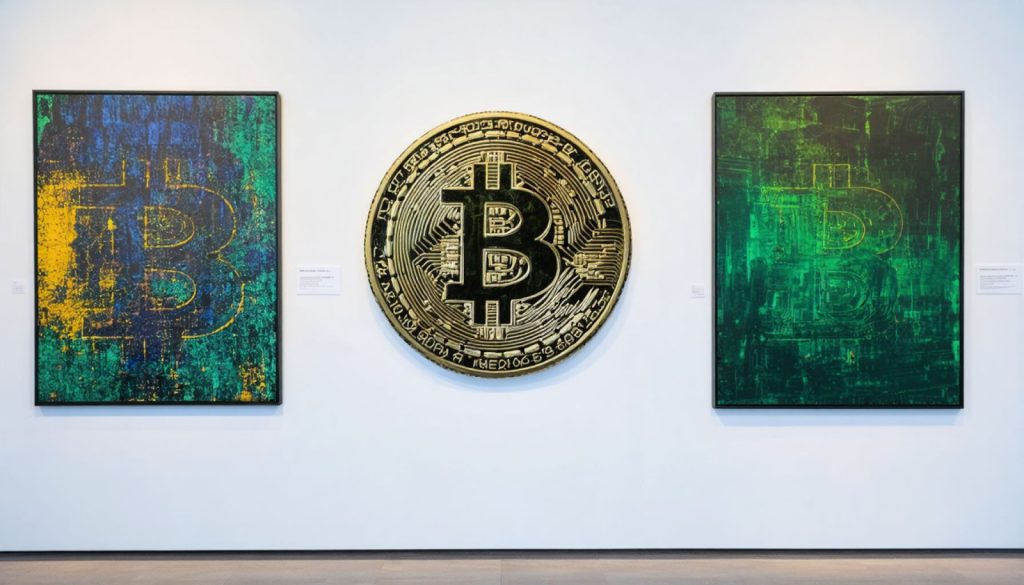
- The art market is undergoing a significant transformation with the integration of digital currencies and blockchain technology.
- Prestigious auction houses like Christie’s and Sotheby’s are embracing cryptocurrencies, reshaping the traditional auction landscape.
- Christie’s recently accepted crypto for AI-generated art, highlighting a shift to modernize and engage tech-savvy collectors.
- Sotheby’s conducted a pioneering event in Saudi Arabia, allowing crypto payments for all auction lots.
- The inclusion of digital currencies attracts younger, tech-oriented buyers, elevating art as a novel investment avenue.
- This trend unites artistic integrity with technological innovation, echoing Warhol’s insight on art and business.
- The art world’s adaptability ensures relevance amid technological change, blending tradition with futuristic prospects.
Glimmers of sleek screens and digital currencies are coursing through the hallowed halls of the world’s most prestigious auction houses, heralding a profound shift in the ever-evolving art market. The rhythmic clatter of traditional bids is now interspersed with the digital cadence of crypto transactions, rewriting the playbook of high-stakes auctions.
Picture this: at a recent groundbreaking auction of AI-generated masterpieces, Christie’s, a stalwart in the domain of fine art, redefined its boundaries by embracing cryptocurrencies with open arms. The echo of the auctioneer’s gavel was met by the discreet chime of digital wallets snapping shut. Similarly, Sotheby’s—the behemoth of the auction world—echoed this sentiment by accepting cryptocurrency for every lot in an ambitious February event hosted in the opulent surroundings of Saudi Arabia.
The inclusion of digital currencies has not merely been a fleeting curiosity but a strategic pivot for these auction giants. In a market that once seemed anchored in the past, blockchain and crypto technology now infuse vibrancy and modernity, courting a fresh wave of young, tech-savvy collectors who see art not just as a passion, but also a novel realm for financially savvy investment.
Marcus Fox of Christie’s shared insights, shedding light on a demographic that once hovered on the fringes—crypto enthusiasts. Their presence in the market has metamorphosed from whispered speculations to a formidable force. This dynamic group no longer lurks in the shadows; they are actively reshaping the contours of the art landscape.
This burgeoning trend signifies a fusion of technological innovation with artistic integrity, remaining true to Warhol’s assertion that “good business is the best art.” The appearance of bitcoin on auction platforms evokes the same response Andy Warhol’s colorful dollar signs once did—a reminder of the times and the cultural pulse.
As auction houses weave cryptocurrency into their fabric, they beckon a question: in a world where bits, bytes, and the brushstroke converge, what future lies ahead for art and commerce? The answer may well lie in the profound ability of the art world to adapt, evolve, and remain ever-relevant amidst the flux of technological progress.
This transformation not only invites art collectors to embrace digital currencies but challenges the broader audience to rethink the intersections where tradition meets innovation. With the allure of crypto capturing the imagination of a new generation, the art world stands at a thrilling intersection of its storied past and a dynamic digital future.
Art Auctions Enter the Digital Age: How Cryptocurrency is Revolutionizing Market Dynamics
The Shift to Digital Transactions in Art Auctions
The art world, steeped in tradition, is undergoing a significant transformation as prestigious auction houses like Christie’s and Sotheby’s embrace cryptocurrency. This shift is not just about modernizing payment systems but also attracting a new generation of art collectors—millennials and Gen Z—who have grown up in a digital age and are eager to engage with art in innovative ways.
How-To: Engaging with Art Auctions Using Cryptocurrency
1. Set Up a Digital Wallet: To participate in auctions accepting cryptocurrency, you’ll need a secure digital wallet to store and transact your digital assets.
2. Stay Informed on Currency Policies: Each auction house may have specific policies regarding the types of cryptocurrency accepted. Always check ahead to ensure compatibility.
3. Understand the Blockchain: Familiarize yourself with how blockchain can offer provenance and authentication, adding value and security to art transactions.
Real-World Use Cases
– Digital Collectibles: AI-generated artworks and digital collectibles are gaining traction. They serve as both cultural artifacts and investment vehicles, authenticated via blockchain.
– Fractional Ownership: Blockchain also enables fractional ownership of high-value pieces, democratizing access to an elite market segment.
Market Forecasts & Industry Trends
The integration of blockchain technology promises greater transparency in provenance and authenticity, which could potentially minimize fraud in the art market. According to a report by Deloitte, blockchain is set to play a pivotal role in the art sector’s future, enhancing both trust and liquidity.
Pros & Cons Overview
Pros:
– Enhanced Transparency: Blockchain allows for immutable records of art provenance.
– Increased Market Participation: Digital currencies lower the entry barriers for younger collectors.
– Global Reach: Cryptocurrencies facilitate cross-border transactions without currency conversion issues.
Cons:
– Volatility: Cryptocurrency values can fluctuate significantly, affecting transaction stability.
– Regulatory Challenges: As governments begin to regulate cryptocurrencies, legal frameworks remain in flux.
– Technological Barriers: Some collectors may find it challenging to navigate digital currencies and blockchain technology.
Reviews & Comparisons
Comparing Christie’s and Sotheby’s approaches highlights an openness to experimentation with blockchain. Christie’s, known for its innovative use of technology, was the first major auction house to sell an NFT (non-fungible token) artwork. In contrast, Sotheby’s has taken a comprehensive approach, incorporating cryptocurrency across various sales and expanding its acceptance geographically.
Security & Sustainability
While blockchain technology offers enhanced security through its decentralized nature, the sustainability of cryptocurrencies remains a topic of debate. The environmental impact of blockchain, particularly regarding energy consumption from mining, is a challenge the art market must address to ensure long-term viability.
Insights & Predictions
Experts predict that as blockchain technology matures, its applications within the art market will expand beyond transactions to include improved mechanisms for artist royalties and copyright management.
Conclusion: Quick Tips for Art Collectors
1. Stay Educated: Continuously learn about blockchain developments and cryptocurrency trends to make informed investment decisions.
2. Network with Tech-Savvy Collectors: Engage with online communities and forums to enhance your understanding and gain insights from seasoned crypto collectors.
3. Diversify Your Portfolio: Consider both traditional and digital art pieces to balance the novelty with stability.
For more information about ongoing auctions and future trends, visit Christie’s and Sotheby’s.



